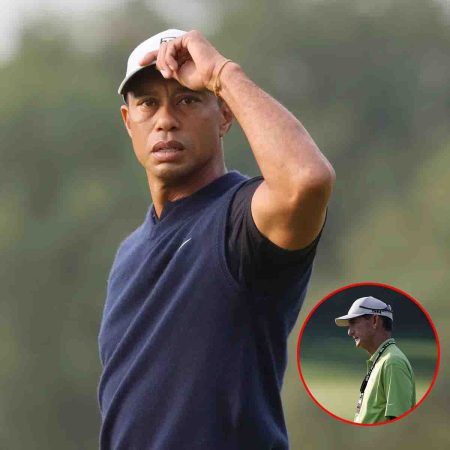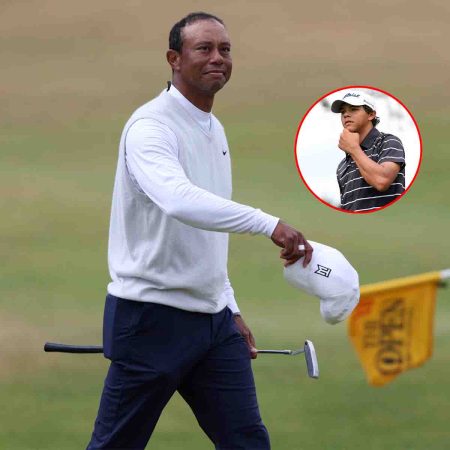
If Arsenal’s 3-2 victory over Manchester United on Sunday afternoon felt particularly momentous, it’s because it was essentially two types of big win combined.
On one hand, it was about Arsenal completely outplaying United, dominating possession and territory, and creating far more chances. On the other, there was the drama of a late winner providing a definitive, exhilarating moment.
But for all Arsenal’s attacking spark, they dominated this game because they were far better organised without possession.
First, here’s a situation after 90 seconds that would define the game. In a 4-2-3-1 shape, Manchester United have their back four in place, then Scott McTominay and Christian Eriksen in front. Bruno Fernandes is supporting them, but the wide players, Marcus Rashford and Antony, are very high. This means Arsenal can easily exploit space on the outsides of United’s holding midfielders, with Oleksandr Zinchenko drifting infield to receive the ball, playing it out to Gabriel Martinelli, and his cutback finding Martin Odegaard. He doesn’t quite connect properly, and his shot is blocked.



But this became a pattern of the game. United’s wide players were slow back into position, which allowed Arsenal space and time in wider positions.
Here’s Martinelli trying to beat Aaron Wan-Bissaka, who largely did well in these situations. The real threat for United, though, was narrower positions. Note Odegaard at the bottom of the above picture, realising he’s in space on the outside of United’s midfield duo.

Here’s another situation, with Granit Xhaka pushing forward on the outside of McTominay.

And here’s Xhaka on the ball again, and Odegaard calling for it again. Rashford is walking back into position.

Arsenal, on the other hand, were impressively compact without possession. Here’s their 4-4-2 block in the opening stages. On this occasion, because of the movement of United’s players, Gabriel is briefly in central midfield and Martinelli is filling in at the back, with Xhaka on the left of midfield. But in a way, that’s the point — Arsenal’s players were capable of covering for one another.

Here’s the 4-4-2 block in a more conventional order.

And here, once again, you see how keenly Saka is protecting Ben White, how tight Arsenal’s lines are, and how difficult they are to play through.

Arsenal’s first goal came in the aftermath of a set piece, which turned into a four-man short corner to get Xhaka in a better crossing position. To begin, it’s worth looking at their first corner of the game, where they did exactly the same thing.
This is a clever routine because it creates space in the channel between the United players going out to the ball, and those waiting to defend a cross. Xhaka finds space, and his pull-back allows Thomas Partey to shoot.


The routine for the goal actually ended up with Xhaka in a less favourable position, but Eddie Nketiah beat Wan-Bissaka at the far post to head home.


But Arsenal were still more threatening from open play, always in the channels where Manchester United were exposed. Again, Rashford isn’t in the picture here, so Odegaard’s pass into Saka is easy, and Luke Shaw is isolated.

What were Manchester United trying to do with their open defensive shape? Well, it at least meant they retained players high up the pitch. Wout Weghorst’s movement towards the ball was clever and he linked play well. He received this forward pass and swept the ball out to Antony, in a good counter-attacking position down the right, although the Brazilian failed to make the most of this situation.

Rashford, who had scored a superb opener after Arsenal twice conceded possession, didn’t offer enough of a threat on the break to justify his freedom from defensive responsibilities. Here, he seemed to misread the path of the ball, allowing Gabriel to recover. If he’d collected it, Antony would have been free to round off a United counter-attack, a familiar sight over the years away at Arsenal.


In terms of pressing, too, United were bypassed easily thanks to Arsenal’s calm build-up play. Here, in the second half, is the best example — five United players committing themselves to press, but a huge gap behind them, allowing Zinchenko to easily poke through midfield into Partey. Look at the space for Partey, and look at Odegaard demanding the ball again.


And the pattern continued throughout the second half. United defended with only six players, Arsenal had freedom in both channels, and Odegaard was always on for a pass.

Arsenal’s second goal came from Saka. It was a very good individual strike but it’s again worth pointing out that Rashford was not even in the picture, leaving it up to a central midfielder, Eriksen, to push out wide and close him down, leaving a big space inside. This is so tempting for Saka to cut inside and shoot, even if Weghorst tried to put him under pressure.


And Saka nearly did the same thing again later in the second half — this time Eriksen’s half-block deflected the ball onto the far post.

Here’s a particularly damning example of Rashford’s lack of responsibility — or determination — to get back and protect Shaw.
Rashford has lost the ball. He’s on the edge of Arsenal’s box, alongside Weghorst. But whereas Weghorst — and Fernandes and Antony — drop back into something approaching a reasonable defensive shape, Rashford is nowhere to be seen. Weghorst is glancing over his shoulder, wondering why United are so open down their left. It again allows Odegaard time on the ball, while Saka has varied his positioning to receive the ball out wide.


Erik ten Hag eventually fixed this issue by introducing Fred, with Eriksen pushing forward to the No 10 role and Fernandes going right. Fred was naturally better than Eriksen at closing down the space in that channel.

But it was in the other channel where Arsenal looked more likely to grab a winner. Here, Antony is vaguely in the right position, but Wan-Bissaka has been dragged out to the touchline, which has left a huge amount of space in the channel. Both Zinchenko and Xhaka find themselves there, and Zinchenko’s clever ball around the corner for Xhaka gets him in a great position, with Nketiah and Saka praying for a ball across the six-yard box.


Arsenal’s winner finally came in the 90th minute. Again, United aren’t protecting their midfield, although right-sided midfielder Fernandes is a little unfortunate here — he was anticipating a United counter-attack, and McTominay had nearly intercepted the ball to stop this Arsenal attack. But again, there’s so much space in front of Wan-Bissaka. Substitute Leandro Trossard is the man to enjoy that freedom, which sucks in Wan-Bissaka and leaves Zinchenko free on the overlap.


And just as Arsenal worked a cut-back to Odegaard in the second minute, they do so again here. Again, Arsenal’s captain doesn’t quite connect properly, but his shot bounces up nicely for Nketiah to convert from close range.


For Arsenal, it was a deserved victory. For Manchester United, it was an important lesson about positioning without possession. There are times when United will get away with an approach like this, but against a side as cohesive and free-flowing as Arsenal, it was always likely to end in tears.
Source: theathletic.com








